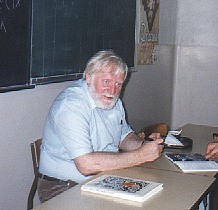
Kir Bulychev
Encyclopedia

Pen name
A pen name, nom de plume, or literary double, is a pseudonym adopted by an author. A pen name may be used to make the author's name more distinctive, to disguise his or her gender, to distance an author from some or all of his or her works, to protect the author from retribution for his or her...
of Igor Vsevolodovich Mojeiko (И́горь Все́володович Може́йко), who was a Soviet and Russia
Russia
Russia or , officially known as both Russia and the Russian Federation , is a country in northern Eurasia. It is a federal semi-presidential republic, comprising 83 federal subjects...
n science fiction
Science fiction
Science fiction is a genre of fiction dealing with imaginary but more or less plausible content such as future settings, futuristic science and technology, space travel, aliens, and paranormal abilities...
writer and historian. He received a Master's degree in 1965 and a Ph.D. in 1981 and wrote his first science fiction story in 1965. Since 1963 he worked in the Institute of Oriental Studies of the USSR Academy of Sciences. He was a specialist in the medieval history of Burma
Myanmar
Burma , officially the Republic of the Union of Myanmar , is a country in Southeast Asia. Burma is bordered by China on the northeast, Laos on the east, Thailand on the southeast, Bangladesh on the west, India on the northwest, the Bay of Bengal to the southwest, and the Andaman Sea on the south....
.
He is known for his series of humorous short stories about Veliky Gusliar, a Russian town that attracts all kinds of aliens and supernatural beings. This fictional city is based on a real Veliky Ustyug
Veliky Ustyug
Veliky Ustyug is a town in the northeast of Vologda Oblast, Russia, located at the confluence of the Sukhona and Yug Rivers. Administratively, it is incorporated as a town of oblast significance . It also serves as the administrative center of Velikoustyugsky District, by which it is completely...
city. Another well known series of Bulychev's stories are young adult stories about Alisa Seleznyova, a young girl from the future. A number of them were made into films, with Guest from the Future ("Гостья из будущего"), based on Bulychev's novel One Hundred Years Ahead ("Сто лет тому вперед"), the most widely known about a girl Alice living in the future. Another famous film was the animated feature The Mystery of the Third Planet
The Mystery of the Third Planet
The Mystery of the Third Planet , aka The Secret of the Third Planet is a 1981 Soviet traditionally-animated feature film directed by Roman Kachanov and produced by the Soyuzmultfilm studio in Moscow...
(1981), for which Bulychev penned the screenplay. Alice's Birthday
Alice's Birthday
Alice's Birthday , is a 2009 Russian animated feature film directed by Sergey Seryogin and produced by Master-film studio. The animated film is based on a story by Kir Bulychyov about Alisa Seleznyova, a young girl living in the second half of the 21st century...
is a 2009 animated film based on one of his tales. He also wrote many science fiction novels, most known among them are "The Last War" (1970), "Thirteen years` voyage", " Those who survive" (screened as an animation film), "The Dungeon of Witches" (screened), "River Chronos", "Abduction of a sorcerer".
Bulychev also translated numerous American science fiction stories into Russian, and wrote scripts for more than 20 movies.
Fiction
- Half a LifeHalf a Life (Kir Bulychev)Half a Life is an collection of science fiction short stories by Russian novelist Kir Bulychev.-Content:The longest of the stories is also called Half a Life and tells the story of a Russian woman kidnapped by an alien spacecraft in the years following the second world war...
(1977) - Gusliar Wonders (1983)
- Earth and Elsewhere (1985)
- Abduction of a Sorcerer (1989)
- Those Who Survive (2000)
- Alice: The Girl from Earth (2002)
History
- 1185 A.D. (1989)
- South-East Asia: Unity in Diversity. Ahmedabad: Allied (with Gennadi Chufrin) (1989).

